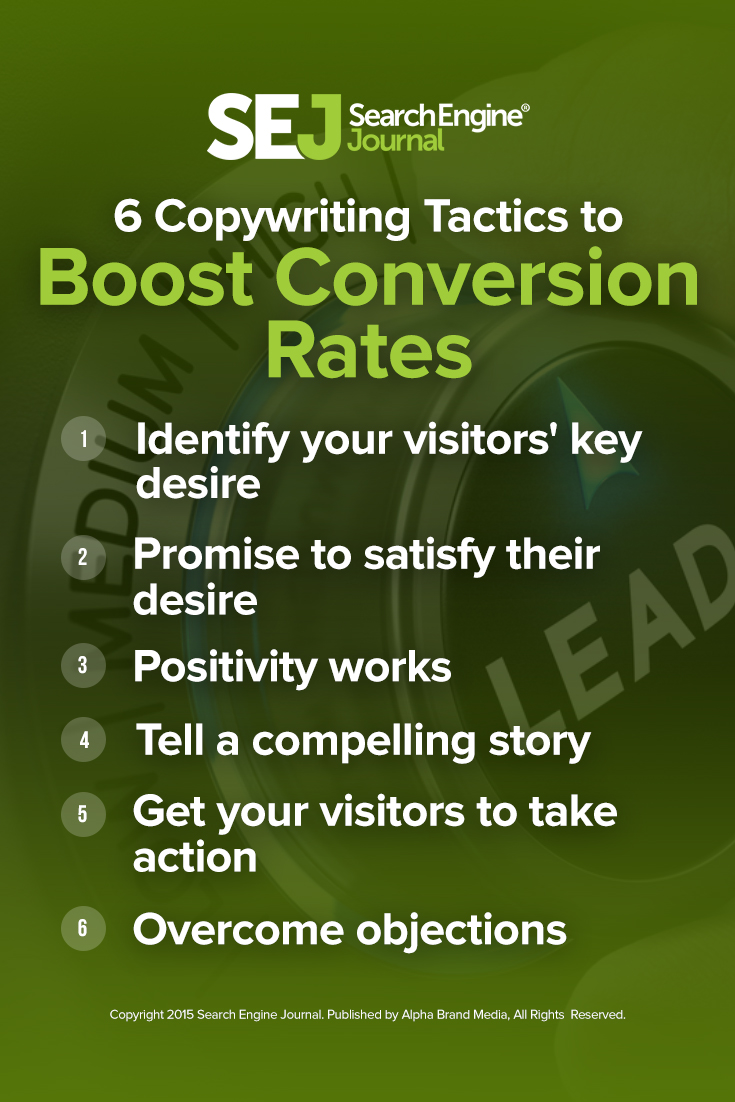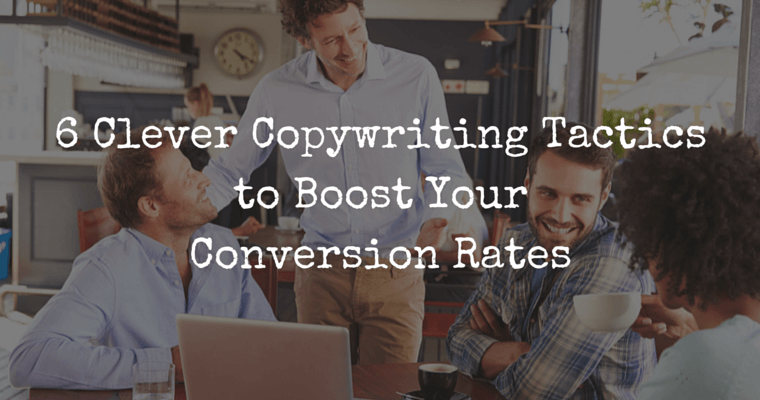Great copywriting is like having a top salesperson selling your stuff 24/7. By using proven copywriting tactics you can boost your conversion rates, turning more of your website’s visitors into customers. Without good copywriting, you could have all the traffic in the world but generate only a trickle of sales.
Conversion rates vary widely depending on the industry. According to MarketingSherpa, average conversion rates by industry range from 10% for professional services to 3% for e-commerce.
Say you want to increase your sales by 50%, you have two options:
- Increase your traffic by 50% -or-
- Improve your conversion rates by 50%
Increasing your traffic by 50% is not easy, and it’s going to take a lot of time and/or money. Now say your conversion rate is 4%. If you can increase it to 6%, you’ve got 50% more sales. You just need to work on your copywriting.
6 Clever Copywriting Tactics to Convert Your Visitors into Customers
With these six clever copywriting tactics, you can boost your conversion rates. This means more of your visitors will be converted into customers. You might be surprised at what you can achieve with a few simple tweaks to your copy. 
1. Identify Your Visitors’ Key Desire
The decision to buy is driven by desire. You must be clear on one thing: you cannot create desire. In the words of legendary copywriter Eugene Schwartz:
Copy cannot create desire for a product. It can only take the hopes, dreams, fears, and desires that already exists in the hearts of millions of people, and focus those already-existing desires onto a particular product.
— Eugene Schwartz
However you can increase desire. But first, you must be able to identify desire. Don’t assume you know what your visitors’ desires are. This is a common mistake. It will lose you sales. Do your homework. The results may surprise you. They are a number of ways you can learn more about your visitor’s desires
Go Through Your Website’s Analytics Data
If you’re using Google Analytics, go to Acquisition > Search Engine Optimization > Queries. You’ll get a list of key phrases that your visitors are inputting into search engines. These key phrases will tell you a lot about what your visitors’ desires are.
Mine Reviews
Copywriting that is written in the words of your visitors is extremely compelling. By mirroring what your visitors are thinking, you will form a powerful psychological connection with them. This will enable your message to be extremely persuasive. Joanna Wiebe from Copy Hackers mines Amazon reviews for products relevant to her client’s niches for quotes she can use in her copy. She used this strategy to increase leads by more than 20% for one client.
Survey Your Visitors
If you have a steady stream of traffic, surveying your visitors is another great way of identifying their desires. Don’t ask them closed or multiple-choice questions. You want then to open up, so ask open questions, such as:
- What’s the biggest problem we can help you with?
- What are you looking for in your ideal solution?
- What questions do you have before buying our product?
2. Make Them a Promise to Satisfy Their Desire
Now you should not only have a better understanding of your visitor’s desires, you know the exact words and phrases they use to express these desires. Can you satisfy these desires? Sure you can. So make them a promise. Identify the strongest desire you can best help your visitors with.
Your goal is to pick a desire that:
- Addresses a strong need in your visitors
- You can fulfill in a way your competitors cannot
Describe this desire in your visitors’ exact words. And make a promise you can fulfill this desire and make their lives easier or better. To make your promise more compelling, try the following:
- Be simple: Don’t use flowery language. Conversion expert Peep Laja recommends one of the following three formulas: 1. Say what it is 2. Say what you get 3. Say what you’re able to do with it.
- Be specific: Is there any statistic about your products and services that would compel your visitors to buy from you? For example, Basecamp mentions “For 12 years and running, over 100,000 companies have adopted the Basecamp way.”
- Be different: If you’re in a competitive market, state what makes you different. It could be what you offer or the way you offer it. Like Whole Foods, and their “America’s Healthiest Grocery Store™” slogan.
- Be targeted: If your services are aimed at small businesses in Tacoma, say so.
- Be personal: Speak to your visitors directly by using the words “you” and “your” in your copy. Like Visa’s classic slogan “It’s everywhere you want to be.”
3. Be Positive
Positivity works. Big time.
It Helps You Go Viral
Scientific American recently conducted a study on the characteristics that make content go viral. After analyzing nearly 7,000 articles, they found that most viral content shares a number of predictable qualities:
- Firstly, content that makes people feel emotions tends to be more widely shared.
- Secondly, content that makes people feel positive emotions is more widely shared than content that makes people feel negative emotions.
For example, one of the articles most highly rated for positivity was “Wide-Eyed New Arrivals Falling in Love with the City”.
And Gets You the Sale
Psychology Today reports that when evaluating brands, consumers tend to use emotions over logic. Their advertising research revealed that the consumer’s emotional response to a written ad is twice as influential over their decision to buy than the ad’s content. Furthermore, their studies showed that positive emotions influence consumer behavior more than rational judgments.
How to Generate Positive Emotions
Positive emotions can include:
- Joy
- Trust
- Interest
- Awe
- Hope
- Amusement
- Inspiration
You can make your content more positive by:
- Sprinkling in positive words and phrases: Like “awesome”, “blissful”, “remarkable”, “sensational”, and “uplifting”.
- Focusing on solving difficult problems: Cite your testimonials and case-studies.
- Writing in a conversational tone: Do this by using short words, short sentences, and short paragraphs. And no jargon, please.
- Flattering your visitor: Like AroundMe’s “Because you’re going places”.
- Using humor: Like Dollar Shave Club’s viral video “Our Blades are F***ing Great.” (Over 22 million views and counting!)
4. Tell a Compelling Story
Stories are awesome for conversions. Consumers are increasingly sophisticated and are have become immune to pushy sales pitches. They need to be engaged with, not sold to. Stories work because they trigger your visitors’ emotions, pulling them in. In fact recent scientific studies have revealed that stories trigger oxytocin production in the brain, generating feelings of empathy.
Great Brand Stories
Jack Daniel’s ‘Bar Stories’ campaign capitalizes on the whiskey brand’s values of heritage and tradition. Their video featuring Frank Sinatra pouring himself a Jack Daniels over a jazz soundtrack exudes the desired timeless cool. Stories also work in less ‘glamorous’ industries.
Microsoft stories step well away from the typical dry corporate marketing material. Instead they take inspiration from digital magazines like Wired. And their stories focus on people, not Microsoft’s products. As Manager of Storytelling Ben Tamblyn says, “Product makes a pretty crappy story. By leading with the story behind the product, you get a far more interesting narrative that people can wrap their arms around.”
Creating Your Own Story
The best brand storytellers use classic narrative structures to craft content that intrigues and engages their audience. Unfortunately this is a skill that few marketers have been trained in. The truth is, any skilled writer can craft a story as long as they understand the basic structure.
American mythologist Joseph Campbell came up with the “Hero’s Journey” which has been used in many successful Hollywood movies from The Wizard of Oz to Star Wars. The hero’s journey has 12 stages from beginning to end. We’re not writing a full-length movie script here, so we can simplify the journey to five stages.
- The Hero: The hero of the story is not you! It is your customer, or someone they can identify with.
- The Goal: What is the hero trying to achieve? Again, their goal must be something your customers can identify with.
- The Obstacle: What is standing in between the hero and their goal?
- The Mentor: Now this is you. This is where you come in to save the day. (Wearing a cape is optional.)
- The Victory: Your hero achieves their goal. And it’s all thanks to you.
5. Get Them to Take Action
The goal of copywriting is to get your visitor to take action. The best way of getting them to take action? Ask them. Simple, but many businesses are shy about asking prospective clients to do something. At the end of your copy, you must provide a clear call to action for your visitors to take.
Don’t make the mistake of cluttering your copy with several different calls to action: follow you on Facebook, subscribe to your newsletter, download your e-book and buy your product. Stick with one call to action per page. Confusing your visitor with different options will hurt your conversions.
It goes without saying that you should have a big colorful button for your visitors to press for them to take action. Red buttons are a favorite, but the most important thing is that the color of your button stands out from the rest of the page.
But don’t let all your great copy go to waste with lame call to action button copy. Like “Buy now”, “Submit”, or “Click here”. The text you use on your button has a big influence on your conversion rates. As marketing guru Robert Cialdini said in his classic book Influence: The Psychology of Persuasion,
A well-known principle of human behavior says that when we ask someone to do us a favor we will be more successful if we provide a reason. People simply like to have reasons for what they do. — Robert Cialdini
So on your call to action button, use action phrases that give your visitors a reason to click that button. The reason? They receive a clearly stated benefit. For example:
- Schedule My Demo
- Get My Free eBook
- Create My Account
- Start Your Free Trial
- Join Our Community
6. Overcome Objections
Now your visitor is hovering over your enticing call to action button. Hopefully they will click and have their lives transformed forever by your amazing products.
But if what if they don’t?
Most likely it’s because they have some objections holding them back. You need to overcome these objections. The best place to overcome them is right next to your call to action button. What you need to say depends on the objection in question:
- How do I know this will work? Include quotes from satisfied customers.
- What if it doesn’t work? Include an ironclad guarantee to reassure anxious buyers.
- How can I trust you? State how long you’ve been trading. Display industry standard certifications.
- Why should I buy now? If availability is limited, say so.
- Why is it so expensive? Offer a free trial or payment plans.
It’s Simple…and It’s Hard
With just a few tweaks in your copy you can significantly increase your conversion rates. Increases from a meager 2.5% to an incredible 591% can be achieved. It seems simple at first. The hard part is figuring out precisely what tweaks you need to make. I’ve given you some copywriting tactics that have been proven to work, time and time again.
Test them out and see which ones work best for you.

Image Credits
Featured Image: Monkey Business/Shutterstock.com
In-post Photo: g-stockstudio/Shutterstock.com





